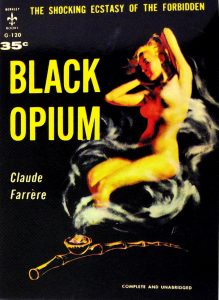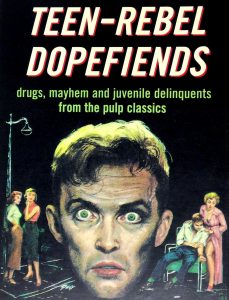This post is part of an ongoing series featuring recently cataloged items from the Ludlow-Santo Domingo Library.
Pulps are so called because of the low quality of paper, coarse untreated paper produced from wood pulp, on which they were printed. Because the quality of paper was so poor it meant that it was cheap thus keeping production costs low and the subsequent cost for the reader low as well. Also because it was already so cheap they didn’t need advertisers within the early magazines. Pulp magazines typically published escapist fiction for the popular entertainment of a mass audience and it was an incredibly successful model. By 1915 it is estimated that a combination of eight of these magazines had a readership of 15% of the U.S. population. These pulp novels featured cover art that revels in exploitation fantasies and lurid depictions of women, teenagers, sex, and drugs. Teen-rebel dope fiends is book of postcards featuring some of the most daring covers which were immediately familiar to me because we have the original pulps in the collection.
 For instance we have this paperback edition of Claude Farrere’s Black Opium, originally Fumée d’opium, translated from the French by Samuel Putnam at Houghton. You can see that the cover blurb appears to feign disgust about the use of opium calling it “…shocking ecstasy of the forbidden”, but the illustration of the woman coming out of the opium pipe is clearly celebrating a sensationalist attitude designed to titillate the readers.
For instance we have this paperback edition of Claude Farrere’s Black Opium, originally Fumée d’opium, translated from the French by Samuel Putnam at Houghton. You can see that the cover blurb appears to feign disgust about the use of opium calling it “…shocking ecstasy of the forbidden”, but the illustration of the woman coming out of the opium pipe is clearly celebrating a sensationalist attitude designed to titillate the readers.  I also noticed the postcard cover of Junkie by William Lee, a pseudonym for William S. Burroughs. This was the first published novel by Burroughs, it was semi-autobiographical and dealt with his experiences with heroin. It was bound back-to-back with Narcotic Agent an abridgement of the memoirs of FBI agent Maurice Helbrant in an attempt to balance out unapologetic stories of drug use. So two books for the low price of 35 cents. The publisher A. A. Wyn also insisted that Burroughs add a preface explaining how someone like Burroughs, a Harvard graduate from a prominent family, was a drug addict.
I also noticed the postcard cover of Junkie by William Lee, a pseudonym for William S. Burroughs. This was the first published novel by Burroughs, it was semi-autobiographical and dealt with his experiences with heroin. It was bound back-to-back with Narcotic Agent an abridgement of the memoirs of FBI agent Maurice Helbrant in an attempt to balance out unapologetic stories of drug use. So two books for the low price of 35 cents. The publisher A. A. Wyn also insisted that Burroughs add a preface explaining how someone like Burroughs, a Harvard graduate from a prominent family, was a drug addict.
The illustration on the cover of Junkie is again typical of these pulps. We see an attractive blond woman in a scarlet skirt being forced to release her desperate grip on a syringe with other drug implements strewn across a table. Confessions of an Unredeemed Drug Addict practically screams at the reader about the depravity of drugs and the unsavory consequences that can be found within its pages. Junkie is particularly interesting because of its evolution of cover art as Burroughs became a respected writer. It transforms from a “cheap shocker” to a respected cult novel by the 50th Anniversary publication.
 Pulps have often been deemed unworthy of study because they epitomize mainstream culture of the 20th-century and until recently not many have been interested in this area of research, particularly academia. I would argue that the look at popular culture is exactly what makes pulps so fascinating to us today and more and more researchers are interested in studying them. However pulps can be challenging to collect because they are so ephemeral and people just read them and never thought about saving them. Also there are preservation challenges because of the cheap paper so they are brittle making handling of them difficult. Luckily for us some collectors saw the value in keeping these types of novels and in the Ludlow-Santo Domingo collection there are an abundance of these pulp novels, many of whose covers are featured in this delightful volume of postcards.
Pulps have often been deemed unworthy of study because they epitomize mainstream culture of the 20th-century and until recently not many have been interested in this area of research, particularly academia. I would argue that the look at popular culture is exactly what makes pulps so fascinating to us today and more and more researchers are interested in studying them. However pulps can be challenging to collect because they are so ephemeral and people just read them and never thought about saving them. Also there are preservation challenges because of the cheap paper so they are brittle making handling of them difficult. Luckily for us some collectors saw the value in keeping these types of novels and in the Ludlow-Santo Domingo collection there are an abundance of these pulp novels, many of whose covers are featured in this delightful volume of postcards.
To get a glimpse of more pulp covers you can find Teen-rebel dope fiends : pulp postcards. London : Prion, 2000 in Widener’s collection.
Thanks to Alison Harris, Santo Domingo Project Manager, for contributing this post.

